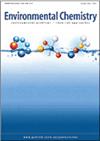中国上海雾霾期间PM2.5的酸度
IF 2.3
4区 环境科学与生态学
Q3 CHEMISTRY, ANALYTICAL
引用次数: 4
摘要
气溶胶酸度,或气溶胶水相pH值,可以影响各种环境过程。基于对颗粒物成分的高频测量,结合热力学计算,本文研究了上海严重雾霾天气过程中的颗粒物酸度,并考虑了其对硝酸盐生成的影响。研究结果将为我们对特大城市雾霾期间PM2.5酸度的解释提供新的视角。气溶胶酸度是影响气候变化和人类健康的重要参数之一,但在中国对其分析不足。在这里,每小时的颗粒成分测量和E-AIM II模型(假设热力学平衡)被用于研究上海严重雾霾期间的颗粒酸度。硫酸盐、硝态氮和铵态氮的总浓度为138.9±50.6 μ m−3,最高为241.3 μ m−3;PM2.5/PM10比值为0.60。检测到的细颗粒物呈偏酸性,pH值范围为0.04-4.50,平均为2.34,高于美国和中国的部分地区。相对较低的颗粒酸度归因于颗粒含水量水平。此外,霾期(病例2)硫酸盐、硝态氮和铵态氮的生长速度比洁净期(CE)快,这是由于霾日高相对湿度(RH)条件下PM2.5酸度的作用加剧所致。最后,在丰富的NH4+条件下,[NO3−]/[SO42−]与[NH4+]/[SO42−]呈显著相关,表明上海NO3−主要通过环境NH3和HNO3的均相反应生成。这些发现为我们对特大城市雾霾期间PM2.5酸度的解释提供了新的视角。本文章由计算机程序翻译,如有差异,请以英文原文为准。
PM2.5 acidity during haze episodes in Shanghai, China
Environmental context Aerosol acidity, or aerosol aqueous phase pH, can affect various environmental processes. Based on high frequency measurements of particulate compositions, along with thermodynamic calculations, this work studies particle acidity in the course of severe episodes of haze in Shanghai and considers the effect of this on the production of nitrate. The results will provide new perspectives on our interpretation of PM2.5 acidity during haze episodes in megacities. Abstract Aerosol acidity is one of the most important parameters that can influence climate change and human health, which has been inadequately analysed in China. Here, hourly measurements of particulate compositions and the E-AIM II model (assuming thermodynamic equilibrium) were used to study particle acidity during severe episodes of haze in Shanghai. The total concentration of sulfate, nitrate and ammonium was 138.9 ± 50.6 μg m−3, maximum 241.3 μg m−3; and the PM2.5 to PM10 (PM2.5/PM10) ratio was 0.60. The fine particles detected were somewhat acidic, with a pH range of 0.04–4.50, average 2.34, which is higher than in some areas of the US and China. The relatively low particle acidity is attributed to particle water content levels. Furthermore, the growth rate of sulfate, nitrate and ammonium during a haze episode (Case 2) was faster than that during a clean episode (CE), owing to exacerbated effects of PM2.5 acidity in the event of high relative humidity (RH) on hazy days. Finally, the detected significant correlations of [NO3−]/[SO42−] with [NH4+]/[SO42−] in conditions of abundant NH4+ indicate that NO3− in Shanghai is primarily formed through homogeneous reaction between ambient NH3 and HNO3. These findings provide new perspectives on our interpretation of PM2.5 acidity during haze episodes in megacities.
求助全文
通过发布文献求助,成功后即可免费获取论文全文。
去求助
来源期刊

Environmental Chemistry
环境科学-分析化学
CiteScore
4.50
自引率
0.00%
发文量
0
审稿时长
2.7 months
期刊介绍:
Environmental Chemistry publishes manuscripts addressing the chemistry of the environment (air, water, earth, and biota), including the behaviour and impacts of contaminants and other anthropogenic disturbances. The scope encompasses atmospheric chemistry, geochemistry and biogeochemistry, climate change, marine and freshwater chemistry, polar chemistry, fire chemistry, soil and sediment chemistry, and chemical aspects of ecotoxicology. Papers that take an interdisciplinary approach, while advancing our understanding of the linkages between chemistry and physical or biological processes, are particularly encouraged.
While focusing on the publication of important original research and timely reviews, the journal also publishes essays and opinion pieces on issues of importance to environmental scientists, such as policy and funding.
Papers should be written in a style that is accessible to those outside the field, as the readership will include - in addition to chemists - biologists, toxicologists, soil scientists, and workers from government and industrial institutions. All manuscripts are rigorously peer-reviewed and professionally copy-edited.
Environmental Chemistry is published with the endorsement of the Commonwealth Scientific and Industrial Research Organisation (CSIRO) and the Australian Academy of Science.
 求助内容:
求助内容: 应助结果提醒方式:
应助结果提醒方式:


